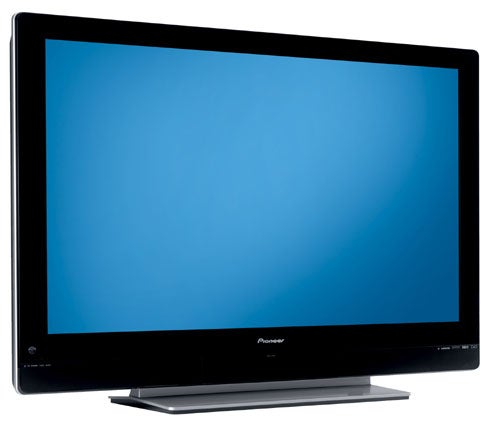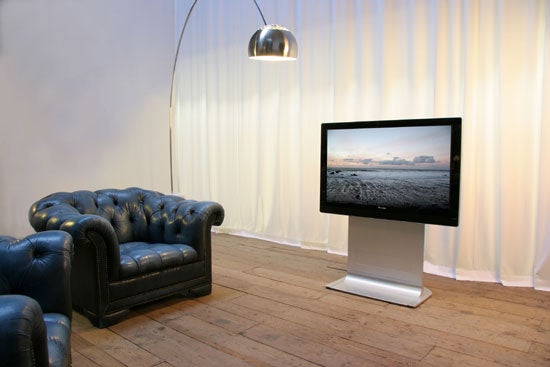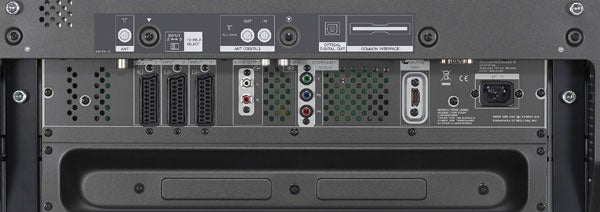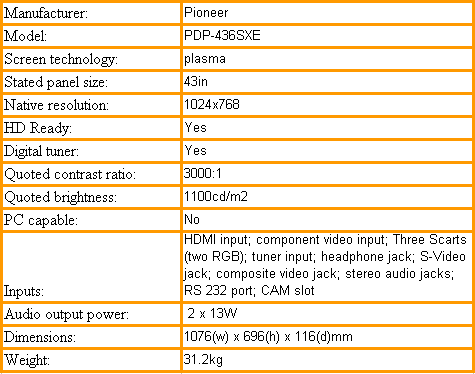Pioneer PDP-436SXE 43in Plasma TV Review
Pioneer PDP-436SXE 43in Plasma TV
If you can't quite afford Pioneer's PDP-436XDE, you're in luck

Verdict
Key Specifications
- Review Price: £2300.00
Without question one of the finest TVs we’ve looked at to date in our pre-World Cup TV marathon has been Pioneer’s PDP-436XDE 43in plasma. But even that slice of home cinema heaven had a couple of issues that might put some people off, namely its slightly high price and its use of a separate external box for tuner and AV connection duties.
Cue Pioneer’s PDP-436SXE: a new 43in plasma model that slashes £500 off the XDE price and shifts all the connections onto the screen itself, making it a more direct, fuss-free replacement for your current TV. But has this more affordable all-in-one approach forced Pioneer to sacrifice any of its trademark quality?

Aesthetically there seems little sign of compromise. In fact, even though it fits the speakers into the main body of the TV rather than providing detachable speakers like the 436XDE does, the 436SXE’s design is arguably even prettier. The speakers are so cunningly integrated that they’re nearly invisible, the chassis looks remarkably compact, there are some new and very cute curves around the screen’s corners, the high-gloss finish is dramatic, and the fascia is stunningly minimalistic. In fact, the only word we can think of to sum the whole thing up is ‘hubba’…
The 436SXE’s connections, however, aren’t quite as impressive as those of its XDE sibling, as moving everything onto the TV has led to three dropouts. For starters we find just one HDMI jack versus the XDE models’ two. Also, there’s no sign of the XDE’s photo-card slot. And most annoyingly, unlike the XDE models there’s no way of attaching a PC. You can still attach an Xbox 360 for HD gaming via a set of component jacks, but we’re sure at least a few of our readers will find the lack of any PC interface pretty distressing.
Elsewhere, though, everything looks OK, with highlights including three SCARTs, an S-Video input, and an RS-232 jack that can, uniquely in the UK plasma world, be used for getting the TV’s picture professionally calibrated to Imaging Science Foundation (ISF) standards.
One final connections point worth making is that most of them are designed facing out rather than down, suggesting that Pioneer expects this screen to be left freestanding rather than wall-mounted in most of its target audience’s rooms.
While the 436SXE’s connections may show signs of compromise, the construction of its screen certainly does not. It boasts all the latest ‘sixth-generation’ tricks employed to such dazzling effect on the XDE model.
For instance, the plasma cells are constructed using a new ‘deep waffle rib’ system that reduces the potential for light and colour to seep between neighbouring pixels. Then there’s a new Crystal Emissive Layer designed to boost contrast and sharpness, and a Direct Colour Filter system for removing the offset secondary image that can appear when watching normal plasma TVs from the side rather than straight on.

Needless to say the 436SXE is fully HD Ready, with a native resolution of 1,024 x 768, while other key specs find healthy brightness and contrast claims of 1100cd/m2 and 3000:1 respectively.
If you’re a bit puzzled by the seemingly 4:3 rather than 16:9 widescreen configuration of the 1,024 x 768 resolution, it’s actually quite easily explained. Essentially the Pioneer ‘stretches’ its pixels horizontally, a process which, it claims, enables them to produce a more natural balance between the red, green and blue phosphors.
The 436SXE also employs the latest generation of Pioneer’s Pure Drive 2HD image processing engine. As usual with such systems, Pure Drive 2 HD actually comprises a variety of processes, including: I-Clear Drive for increasing the range of gradation levels (thus delivering more subtle colour differences); a sophisticated Dynamic High Definition Converter for turning interlaced PAL/NTSC into progressive high resolution; colour management procedures; standard and MPEG noise reduction circuits; and a Dynamic Range Expander that enhances light and dark areas based on a dynamic real time analysis of the complete image content.
Other significant findings on the 436SXE include a fully specified digital tuner, colour fine-tuning tools, and the facility to switch between 75Hz and 100Hz in case you find one mode works better than the other for different kinds of footage.
And so to the moment of truth: does the 436SXE’s performance match that of the stunning XDE models? Happily, when it comes to pictures it does. In fact, the 436SXE’s images are, as far as we can tell, absolutely identical in quality to those of the 436XDE.
For starters, this means that high definition footage looks sensationally sharp and detailed, with supreme amounts of texture and practically no video noise to spoil the show.
Colours are exceptional too, in terms both of their vibrancy and how naturally toned they are, even with tricky skin tones during dark scenes.

Rich, natural colours are commonly accompanied by a good contrast performance, and so it proves here, as the 436SXE’s black levels succeed in being both profoundly deep and jam-packed with the sort of subtle shading that gives pictures more depth and vitality.
Motion, meanwhile, looks wonderfully smooth and sharp, with practically no trace of the sort of softness or dotting noise still seen on numerous plasma TVs. Also impressive is how flexible the 436SXE is, with even standard definition pictures from its digital tuner looking surprisingly clean, sharp and enticing.
As with the 436XDE, analogue tuner footage can start to look a touch rough on the 436SXE. And the sheer richness of its colours mean you have to be even more careful about screen burn than normal, especially during the first 100 hours or so of the TV’s life. But otherwise the 436SXE’s pictures are simply as good as flat TV gets.
The 436SXE isn’t quite as accomplished sonically, however. The built in speakers simply don’t have as much bass as the external ones found with other Pioneer sets, reducing the impact of action scenes. The speakers still produce clear trebles without harshness, though, along with rich, clean dialogue. So they remain pretty good by flat TV standards.
”’Verdict”’
Pioneer’s bid to deliver a cheaper, simpler plasma option isn’t wholly without its compromises – especially the lack of a PC connection. But the most important thing is that it’s still got picture quality to die for.

How we test televisions
We test every TV we review thoroughly over an extended period of time. We use industry standard tests to compare features properly. We’ll always tell you what we find. We never, ever, accept money to review a product.
Trusted Score
Score in detail
-
Value 8
-
Image Quality 10
-
Sound Quality 8

